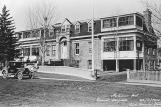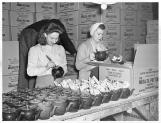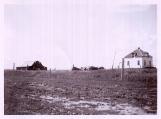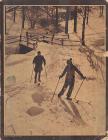2
Enge was just 16 years old - a pretty dark haired girl with a lively expression and an easy laugh. With her older sister, Margaret, she arrived in the city "fresh off the farm" and "dumber than a doorknob", to use her words, seeking work.4
They found accommodations in a private home where they shared one tiny room and were allowed use of the kitchen. They found jobs through the local Canada Manpower Office where they learned that Medalta Potteries was hiring and, on February 1, 1945, a very blistering cold day, they began their employment there - a 6 day week with a half hour lunch and 10 minute coffee breaks.Their parents, Christian and Barbara Stappler, were sodbusters who had a farm 45 miles out of Medicine Hat on the Etzikom Road. Mr. Stappler was more used to a horse than a car and could often be heard to yell "whoa" to try and stop his vehicle. It wasn't surprising that Enge thought her father to be the world's worst driver.
5
Medicine Hat General Hospital, Medicine Hat, Alberta, Canada20th Century, Circa 1925
Medicine Hat, Alberta, Canada
 Credits:
Credits:Esplanade Archives, Medicine Hat, Alberta
Gainsborough Studio Fonds
6
Enge was born on May 18, 1928 at the Medicine Hat General Hospital. She was the second youngest of 13 children. It was a lively household with siblings ranging greatly in age. When Enge was only in primary school, some of her sisters were already married. This caused a bit of a generation gap.Once, when her parents were going into town on errands, they dropped Enge off at the house of one of her older siblings. As the two sisters waited for their parents' return, the older remarked that she "didn't know when Mom and Dad will be back" to which little Enge retorted "They're not YOUR Mom and Dad, they're MY Mom and Dad." Needless to say, she got a good lecture that day.
8
Her first job at the factory was as a sponger, initially with Tilly Schlenker and then with "Slim" Sailor. At the stage that a ceramic piece became leather hard and was still malleable, it had to be checked for surface imperfections. These small flaws could be smoothed out with water and a sponge - a simple enough task, but in winter, the water was very cold and working gloveless under such conditions was painful. In those first few days, Enge's hands became so cramped and chapped that she thought she wouldn't be able to continue.9
Preparing teapots for packaging20th Century, Circa 1940's
Medalta Potteries Limited, Medicine Hat, Alberta, Canada
 Credits:
Credits:Friends of Medalta Society Archives
10
Her next job was in the packing room with Chris Stickle. Here she used a metal tool called a chipper and took the rough edges off the products before they were packed. Sometimes she would have to use the chipper to knock off the stilts that were stuck to the bottoms of the ware, or file down the very sharp and uneven edge of glass-like glaze. This was also hard on the hands, daily causing numerous tiny cuts and scratches.11
Banding section of the Medalta Potteries art department20th Century, Circa 1940's
Medalta Potteries Limited, Medicine Hat, Alberta, Canada

12
Her final job at Medalta was the one she loved and that was in the Art Department with Tom Hulme. There she was taught by Tom to do plate banding using the flat wheel. Banding was the term used to describe the painting of circular lines on dinnerware. One hand would manually turn a platform or wheel. The other hand, with the aid of an armrest, would hold the brush steady. The object to be painted - a saucer or dinner plate - was held in place on the wheel by three pins. The palette of colours and the brushes would be in front of the banding machine. Once completed, the banded object would be placed on an adjacent conveyor belt which ran down to the firing area.There was also the hollow ware banding machine, used for cups and bowls, but Enge only worked on the plates. Hotel ware and special orders made up the bulk of her work. She was paid by the piece and was making a satisfactory wage because of the number of plates she could complete in a day.
14
She kept a meticulous log of her personal banding production in the years 1949 through 1953 - nine scribblers notated in exemplary handwriting. A sample entry taken from Monday, August 29, 1949 reads:Maroon 6" plates 50
saucers 320
green saucers 830
Total 1200



